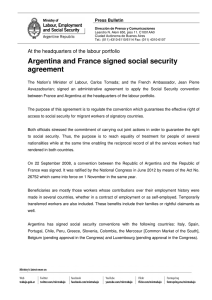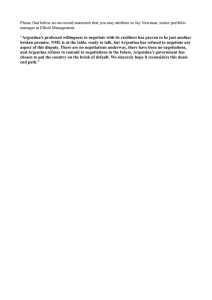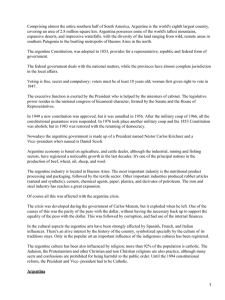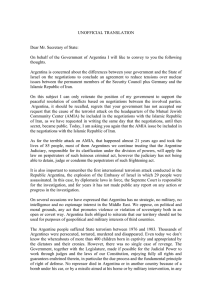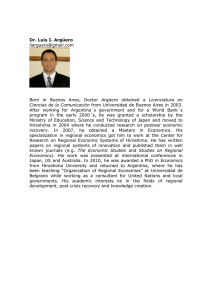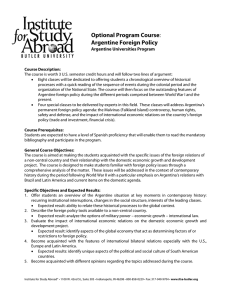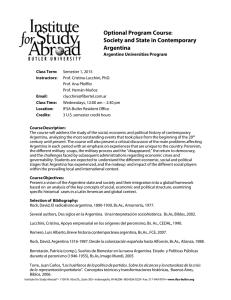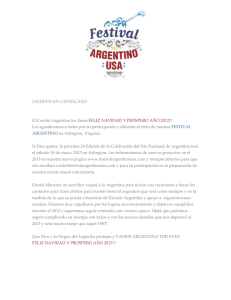latin american thought since independence
Anuncio
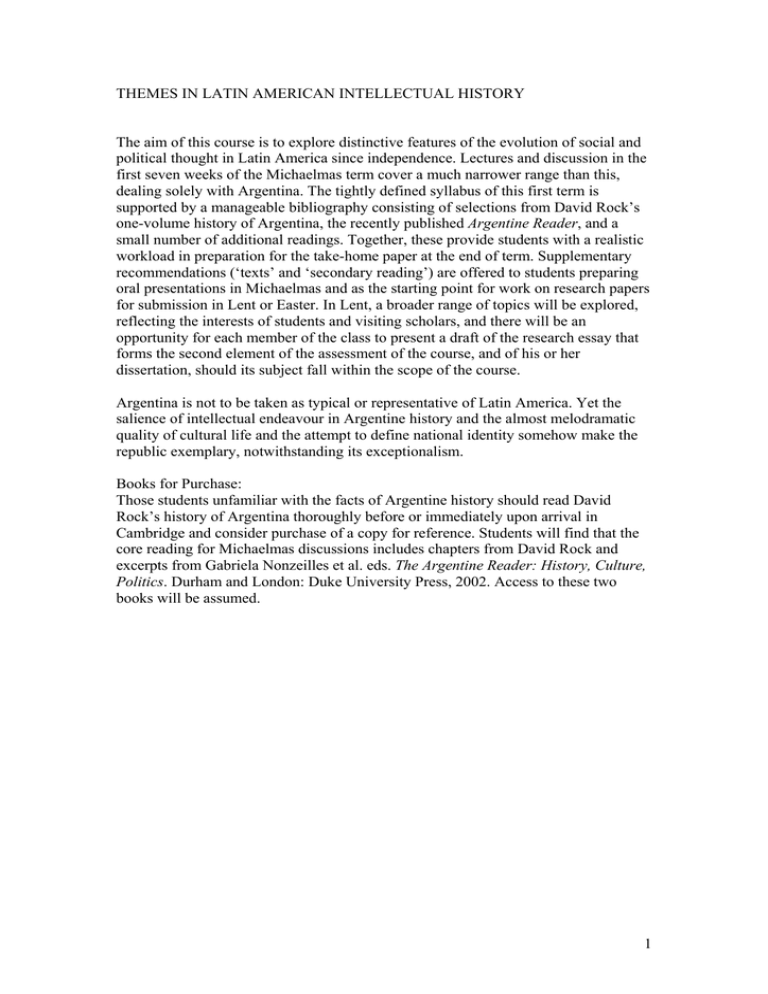
THEMES IN LATIN AMERICAN INTELLECTUAL HISTORY The aim of this course is to explore distinctive features of the evolution of social and political thought in Latin America since independence. Lectures and discussion in the first seven weeks of the Michaelmas term cover a much narrower range than this, dealing solely with Argentina. The tightly defined syllabus of this first term is supported by a manageable bibliography consisting of selections from David Rock’s one-volume history of Argentina, the recently published Argentine Reader, and a small number of additional readings. Together, these provide students with a realistic workload in preparation for the take-home paper at the end of term. Supplementary recommendations (‘texts’ and ‘secondary reading’) are offered to students preparing oral presentations in Michaelmas and as the starting point for work on research papers for submission in Lent or Easter. In Lent, a broader range of topics will be explored, reflecting the interests of students and visiting scholars, and there will be an opportunity for each member of the class to present a draft of the research essay that forms the second element of the assessment of the course, and of his or her dissertation, should its subject fall within the scope of the course. Argentina is not to be taken as typical or representative of Latin America. Yet the salience of intellectual endeavour in Argentine history and the almost melodramatic quality of cultural life and the attempt to define national identity somehow make the republic exemplary, notwithstanding its exceptionalism. Books for Purchase: Those students unfamiliar with the facts of Argentine history should read David Rock’s history of Argentina thoroughly before or immediately upon arrival in Cambridge and consider purchase of a copy for reference. Students will find that the core reading for Michaelmas discussions includes chapters from David Rock and excerpts from Gabriela Nonzeilles et al. eds. The Argentine Reader: History, Culture, Politics. Durham and London: Duke University Press, 2002. Access to these two books will be assumed. 1 THE SYLLABUS WEEK BY WEEK: 1. Revolution, Nation, State: the colonial heritage − Revolution to Rivadavia − Rosas and the generation of ’37 − the invention of the nation. Core Reading: Rock, chapters 2 – 4; Argentine Reader, sections 1 and 2. Anthology: • Tulio Halperín Donghi, ‘Argentines Ponder the Burden of the Past’ in Jeremy Adelman, ed. Colonial Legacies: the Problem of Persistence in Latin American History. (Routledge, 1999). • David Rock. ‘The European Revolutions in the Río de la Plata’. In Guy Thomson, ed. The European Revolutions of 1848 and the Americas. London: ILAS, 2002. Texts: • • • • Domingo Faustino Sarmiento. Life in the Argentine Republic. Juan Baptista Alberdi. Bases y puntos … José Hernández. Martín Fierro. Esteban Echeverría. Dogma Socialista. Secondary works: • Nicolas Schumway. The Invention of Argentina. 1991. • Jeremy Adelman. Republic of Capital. Stanford CA: Stanford University Press, 1999. • John Lynch. Argentine Dictator: Juan Manuel de Rosas, 1829-1852. Oxford: Clarendon, 1981. • Natalio R. Botana. La libertad política y su historia. Buenos Aires 1991. • Diana Goodrich. Facundo and the Construction of Argentine Culture. Austin, Texas: University of Texas Press, 1996). • Mark D. Szuchman and Jonathan C. Brown, eds. Revolution and Restoration: the Rearrangement of Power in Argentina, 1776-1860. Lincoln, Nebraska, and London: University of Nebraska Press, 1994. • William H. Katra. The Argentine generation of 1837: Echeverría, Alberdi, Sarmiento, Mitre. London: Associated University Presses, 1996. • Tulio Halperín Donghi et al., eds. Sarmiento: Author of a Nation. Berkeley CA: University of California Press, 1994. • Joseph T. Criscenti, ed. Sarmiento and his Argentina. Boulder CO and London: Lynne Rienner, 1993. 2 2. Violent Frontiers: the wars of independence −wars against indigenous peoples − European interventions − the Triple Alliance − the place of the military in national life. Core Reading: Rock, chapters 3 – 5; Reader, section 3. Anthology: Texts: • Juan B. Alberdi. La Guerra del Paraguay. • Juan B. Alberdi. The Crime of War. London 1913. • Lucio V. Mansilla. A Visit to the Ranquel Indians. Lincoln, Nebraska, and London: University of Nebrask Press, 1997. Secondary works: • Susan Migden Socolow. ‘Spanish Captives in Indian Societies: Cultural Contact along the Argentine Frontier, 2600-2835’. Hispanic-American Historical Review, 72:1 (February 1992), 73-. • Vera Blinn Reber. ‘The Demographics of Paraguay: a Reinterpretation of the Great War, 1864-70’. Hispanic-American Historical Review, 68:2 (May 1988), 289-. • Pirate wars (on Lopez). 3 3. The Modern City: The positivist project − spaces in the city − immigration, anarchism, tango, miscegenation, and white slaving − modernity and psychoanalysis − high culture in the Paris of the South. Core Reading: Rock, chapters 5 – 7; Reader, sections 4 and 5. Anthology: • John King. ‘Towards a Reading of the Argentine Literary Magazine Sur’. Latin American Research Review, 16:2 (1981), 57-78. • Mariano Ben Plotkin. ‘Freud, Politics, and the Porteňos: the Reception of Psychoanalysis in Buenos Aires, 1910-1943’. HAHR, 77:1 (February 1997?), 45-74. Texts: • Jorge Luis Borges. ‘A History of the Tango’. In Jorge Luis Borges. The Total Library. Penguin. 394-404. • Donald S. Castro. The Argentine Tango as Social History, 1880-1955: the Soul of the People. The Edwin Mellen Press, 1991. Valuable for extensive quotations from tango lyrics. • Simon Collier • Carlos Gardel. ‘Lo mas grande’. Sound recording. • Oscar Terán. José Ingenieros: pensar la nación, antología de textos. Buenos Aires: Alianza, 1986. • Carlos Octavio Bunge. Nuestra América. Bs As: Casa Vaccaro, 1918 [1903]. Secondary works: • David Viňas. Literatura argentina y realidad política. Bunos Aires: CEAL, 1982. • Julio Ramos. Divergent Modernities: Culture and Politics in the Nineteenth century. Durham NC: Duke University Press, 1999. • Ariel Dorfman. ‘Borges and American Violence’. In Ariel Dorfman. Some Write to the Future: Essays on Contemporary Latin American Fiction. Durham NC and London: Duke University Press, 1991. • M. Savigliano. Tango and the Political Economy of Passion. Boulder, CO: Westview, 1995. • John King. Sur: A Study of the Argentine Literary Journal and its Role in the Development of a Culture, 1931-1970. Cambridge: CUP, 1986. • Doris Meyer. Victoria Ocampo: Against the Wind and the Tide. University of Texas Press, 1990. • Mariano Plotkin. Freud in the Pampas: the Emergence and Development of a Psychoanalytical Culture in Argentina. Stanford CA: Stanford UP, 2001. • Hugo Vezzetti. Aventuras de Freud en al país de los argentinos. Buenos Aures: Paidós, 1996. • Donna Guy. Sex and Danger in Buenos Aires: Prostitution, Family and Nation in Argentina. Lincoln: University of Nebraska Press, 1991. • Adrian Gorelik. La grilla y el parque: espacio público y cultura urbana en Buenos Aires, 1887-1936. Buenos Aires: Universidad Nacional de Quilmes, 1998. 4 4. Nationalism and Populism: Roots of populism − Xenophobia − Radicalism, Nationalism, Peronism. Core Reading: Rock, chapters 6 and 7; Reader, section 6. Anthology: • David Rock. ‘Intellectual Precursors of Conservative Nationalism in Argentina, 1900-27’. Hispanic-American Historical Review, 67:2 (May 1987), 271 -. • Alan Knight. ‘Populism and Neo-populism in Latin America, especially Mexico’. Journal of Latin American Studies, 30 (1998), 223-248. Texts: • Ricardo Güiraldes. Don Segundo Sombra. [1926]. Various editions, but preferred edition (with useful commentaries) is Pittsburgh and London: University of Pittsburgh Press for UNESCO, 1995. Secondary works: • Jeanne H. Delaney. ‘Imagining El Ser Argentino: Cultural Nationalism and Romantic Concepts of Nationhood in Early Twentieth-Century Argentina’. Journal of Latin Amrican Studies, 34:3 (August 2002), 625-658. • David Rock. Authoritarian Argentina: the Nationalist Movement, its History, and its Impact. Berkeley, Los Angeles, Oxford: University of California Press, 1993. • Sandra McGee Deutsch. Las derechas: the Extreme Right in Argentina, Brazil, and Chile, 1890-1939. Stanford, CA: Stanford University Press, 1999. • Sandra McGee Deutsch. Counterrevolution in Argentina, 1900-1932: the Argentine Patriotic League. Lincoln, Nebraska, and London: University of Nebraska Press, 1986. • Sandra McGee Deutsch and Ronald H. Dolkart, eds. The Argentine Right: its History and Intellectual Origins, 1910 to the Present. Wilmington, Delaware: SR Books, 1993. • James P. Brennan, ed. Peronism and Argentina. Wilmington, Delaware: SR Books, 1998. 5 5. A Power in the World: International Law and non-intervention − hemispheric rivalries and geopolitical thought − the Inter-American System − the external implications of economic structuralism. Core Reading: Anthology: • Albert P. Vannucci. ‘The Influence of Latin American Governments on the Shaping of United States Foreign Policy: the case of U.S.-Argentine Relations, 1943-1948’. Journal of Latin American Studies, 18 (1986), 355-382. • Deborah L. Norden and Roberto Russell. ‘Autonomous Argentina’. Chapter 1 of their The United States and Argentina. Routledge, 2002. • Kathryn Sikkink. ‘The Influence of Raul Prebisch on Economic PolicyMaking in Argentina, 1950-1962’. Latin American Research Review, 23:2 (1988), 91-114. Texts: • Jorge Luis Borges. ‘Notes on Germany and the War’. In The Total Library (Penguin), 197-213. • Prebisch’s address and discussion in di Tella and Platt, eds. 1986. Secondary works: • Robert N. Burr. ‘The Balance of Power in Nineteenth-Century Latin Amrica’. Hispanic-American Historical Review, 35:1 (1955). • McGann. Argentina, the United States, and the Inter-American System. 1937. • Francis Anthony Boyle. Foundations of World Order: The Legalist Approach to International Relations, 1898-1922. Duham and London: Duke University Press. Chapter 1. • Joseph S. Tulchin. Argentina and the United States. Boston: Twayne (G. K. Hall), 1990. • Guido di Tella and D. Cameron Watt, eds. Argentina between the Great Powers, 1939-46. Houndmills: Macmillan for St Antony’s, 1989. • Carlos Escudé. La Argentina vs. las grandes potencies: el precio del desafío. Buenos Aires: Belgrano, c.1986. • Carlos Escudé. Estados Unidos y la declinación argentina, 1942-1949. Buenos Aires: Belgrano, 1983. • Carlos Escudé. ‘An Introduction to nPerihperal Realism and its Implications for the Interstate System: Argentina and the Cóndor II Missile Project’. In Stephanie G. Neuman, ed. International Relations Theory and the Third World. Houndmills: Macmillan • Mario Rapoport. ‘Argentina and the Soviet Union: History of Political and Commercial Relations, 1917-1955. Hispanic-American Historical Review, 66:2 (May 1986), 239-286. • Raanan Rein. The Franco-Peron Alliance: relations between Spain and Argentina, 1946-1955. Pittsburgh and London: University of Pittsburgh Press, 1993. • Callum McDonald. Various. • CEPAL. ‘Homenaje a Prebisch’. 6 • • • Dimus D. James. ‘Economic development Theory and Policy in Latin America: the Second World War to the Present’. In Harry Costin and Hector Vanolli, eds. Economic Reform in Latin America. The Dryden Press. Robert A. Pakenham. The Dependency Movement: Scholarship and Politics in Development Studies. Cambridge MA: Harvard University Press. Chapter 1. Peter Whitney. ‘Economics of Modern Latin America: Books to Explain the Present and Bury the Past’. Latin American Research Review. 7 6. Revolutionary and Counterrevolutionary Violence and Memory Core Reading: Rock, chapter 8; Reader, sections 7 and 8 and elements of 10. Anthology: • Tulio Halperín Donghi. ‘Argentina’s Unmastered Past’. Latin American Research Review, 23:2 (1988), 3-24. Texts: • Nunca más: informe de la Comisión Nacional sobre la Desaparición de Personas. Buenos Aires 1994. • Bemberg’s ‘Camilla’. (Film). Secondary works: • J. G. Castaňeda. Compaňero: the Life and Death of Che Guevara. 1998. • Juan E. Corradi et al. eds. Fear at the Edge: State Terror and Resistance in Latin America. Berkeley and Los Angeles: University of Califonia Press, 1992. • Marguerite Feitlowitz. A Lexicon of Terror: Argentina and the Legacies of Torture. New York and London: Oxford University Press, 1998. 8 7. Faith, Race, and Gender: recovering and reinventing culture and civil society after dictatorship in conditions of flawed democracy and globalisation. Core Reading: Anthology: • Karen Mead. ‘Gendering the Obstacles to Progress in Positivist Argentina, 1880-1920’. Hispanic-American Historical Review 77:4 (November 1977), 645-675. • Eduardo A. Zimmermann. ‘Racial Idea and Social Reform: Argentina, 18901916’. Hispanic-American Historical Review, 72:1 (February 1992). 23 -. Texts: • Domingo Faustino Sarmiento. Conflicto y armonía de las razas en América. Buenos Aires: La Cultura Argentina, 1915 [1883]. Secondary works: • Austen Ivereig. Catholicism and Politics in Argentina, 1810-1960. New York: St Martin’s, 1995. • Emilio Fermín Mignone. Witness to the Truth: the Complicity of Church and Dictatorship in Argentina, 1976-1983. New York: Orbis, 1988. • Frank Graziano. Divine Violence: Spectacle, Psychosexuality, and Radical Christianity in the Argentine ‘Dirty War’. Bounder CO: Westview, 1992. • Asunción Lavrin. Women, feminism and Social Change in Argentina, Chile and Uruguay, 1890-1940. Lincoln, Nebraska: University of Nebraska Press, 1995. • Marifran Carlson. Femenismo! The Woman’s Movements in Argentina from its Beginnings to Eva Peron. Chicago: Academy, 1988. • Francine Masiello. Between Civilization and Barbarism: Women, Nation and Literary Culture in Modern Argentina. Lincoln, Nebraska: University of Nebraska Press, 1992. • Marysa Navarro. ‘Evita and the Crisis of 17 October 1945: a Case Study of Peronist and Anti-Peronist Mythology’. Journal of Latin American Studies, 12:1 (1980), 127-138. • Nancy Leys Stepan. ‘The Hour of Eugenics’: Race, gender, and Nation in Latin America. Ithaca: Cornell University Press, 1991. 9

